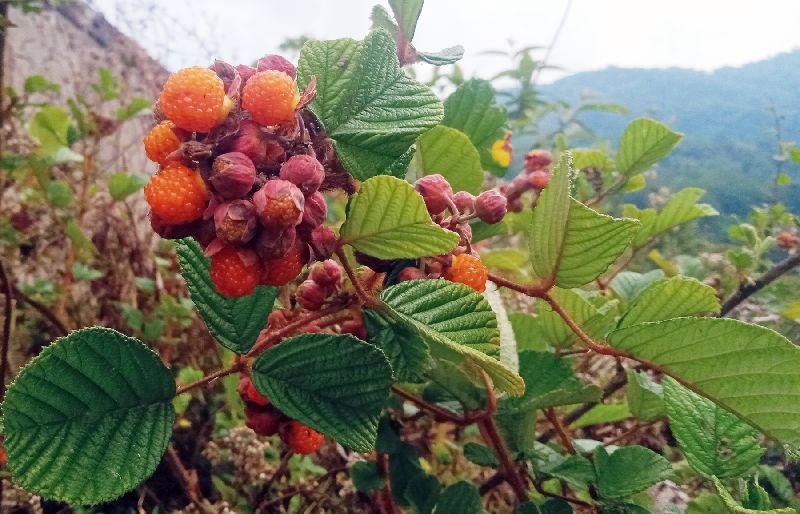Raspberry along the roadside of Kigwema village in Kohima district. Varieties of wild fruits are found in different parts of Nagaland. (Morung Photo by Chizokho Vero)

Nagaland observes International Day for Biological Diversity 2020
Our Correspondent
Kohima | May 22
Nagaland’s Environment, Forest & Climate Change and Law & Justice CM Chang made a fervent appeal to all citizens of the state to conserve nature, forest and wildlife, biodiversity and take significance of biodiversity in planning and implementing development programme.
The state of Nagaland is very rich in biodiversity, having variety of flora and fauna. In spite of being small state with 16, 579 sq. km. geographical area, there are 6 types of forests found here. The angiospermic flora is represented by 2431 species belonging to 963 genera and 186 family.
In this, share of dicots is 1688 species, 724 genera and 158 families and monocots by 743 species under 239 genera and 28 families Gymnosperms also registers their presence with 9 species under 6 genera from 5 families, the minister said while addressing the International Day for Biological Diversity 2020 here.
A short programme was jointly organized on May 22 by Nagaland State Biodiversity Board (NSBB) and Kohima Press Club with limited number of participants and maintaining social distancing protocol in the wake of COVID -19 pandemic.
The occasion also witnessed release of short film and illustrated booklet on “Our solutions are in nature.”
Mission mode for biodiversity conservation needed
The Minister said that Nagaland harbours a large number of plants species which are endemic to the state or the North East part of India.
The state is having tallest Rhododendron (108 feet), tallest paddy (9.2 feet), and hottest Raja Chilly, a variety of medicinal plants, orchids, bamboos, wild edible fruits, ornamental plants, mammals, birds, reptiles, fishes, domesticated cattle, agro and horticultural biodiversity.
Maintaining that biological resources are required to be nurtured for their sustained supply to our future generation, the minister said “There is need of working in mission mode for biodiversity conservation, with an objective of turning the tide of destruction into a new, positive relationship between people and nature.”
“Thus, the policy and planning mechanisms in every sphere of development should accommodate the concept/ aspect of biodiversity conservation,” the minister said.
‘Our solutions are in nature’
Talking on this year theme “Our solutions are in nature,” he said “the theme is very important; as we are facing COVID-19 pandemic.”
The minister said that nature had been abused due to various reasons mainly developmental activities without concern of biodiversity, increasing human population, increasing standard of life which requires more natural resources.
“Despite all our technological advances, we are completely dependent on nature which provide us healthy and vibrant ecosystems for meeting our basic needs namely food, water, medicines, clothes, fuel, shelter, energy etc,” the minister said.
Co-existence of human beings with nature
The minister said that Government of Nagaland had implemented the Wildlife (Protection) Act,1972 since 18 December 1981 by taking into account the importance of nature, forest and wildlife, in our life.
With the support of the Ministry of Environment, Forest & Climate Change, Government of India, New Delhi, the Nagaland forest department upgraded three institutions as Nature Learning Centres under the National Mission of Himalayan Studies (NMHS) for imparting training to children, students and communities and others on co-existence of human beings with nature.
It includes; Conference Hall of the Forest Offices Complex, Dimapur, Nagaland Zoological Park, Rangapahar, Dimapur and Botanical Garden, Kohima.
“A good number of children, students, communities are visiting these learning centres and they have been trained by the forest officers for nature conservation,” the minister stated.
“Let us introspect ourselves and co-exist with nature,” the minister said.
Nagaland State Biological Diversity Rules
NSBB member secretary and CCF Supongnukshi Ao said that Nagaland State Biological Diversity Rules 2012 has been enacted and these rules are being implemented through NSBB.
The NSBB have mandated to form Biodiversity Village Management Committee in all the villages and about 90% have been covered so far. Once the Committee is formed, the NSBB are mandated to document the biological resources in that village jurisdiction.
“We are documenting all the resources like plants, animals as well as traditional resources, traditional knowledge and practices,” CCF said.
NSBB chairman Satya Prakash Tripathi also delivered short speech.






